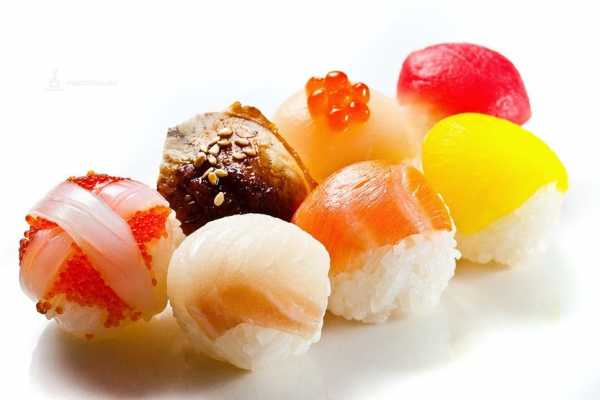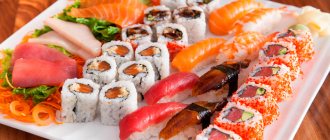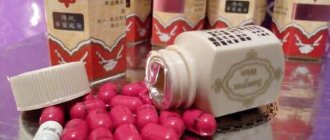The Japanese prefer food with a minimum of heat treatment, and the diet is dominated by rice, seafood, vegetables, and legumes. Such dishes look very elegant and original, one thing is interesting: can you gain weight from rolls or not?
These are peculiar small rolls with fish, rice, seaweed and vegetables. Today there are a lot of recipes for preparing such dishes; if desired, you can add other ingredients, sometimes high-calorie ones, to them. That’s why some people don’t gain weight from eating rolls, while others, on the contrary, quickly gain weight.
The benefits and harms of such products
All the ingredients that make up these “delicacies” are natural and have a lot of beneficial properties. The products are rich in vitamins and chemical elements.
- Rice gives the body energy and maintains natural beauty.
- Fish perfectly helps maintain youth, promotes accelerated regeneration of dead cells, supports clear thinking and good memory.
- Seaweed contains iodine for the effective functioning of the thyroid gland.
- And vegetables are filled with useful vitamins and minerals to normalize metabolism and improve the immune system.
Japanese cuisine: sushi makes you fat!
The example of slender Japanese people who live happy and healthy to over 90 years old turned out to be very contagious, so instead of rich borscht we began to lean on miso soup with wakami seaweed, fried cod and potatoes were exchanged for raw tuna, and we preferred sandwiches with red caviar rice with small flying fish eggs.
Most nutritionists do not approve of this diet. In their opinion, our food enzymes are evolutionarily adapted to digest local products or, in extreme cases, dishes from nearby regions - for example, German sausages, Italian pasta or Uzbek pilaf. The body can react negatively to exotic ingredients and spices, so experts advise not to abuse them. Moreover, it is not only the famous fugu fish that poses a danger, but also such seemingly harmless treats as salmon sashimi, tuna sushi or California rolls. Skip the sashimi
To prepare sushi and sashimi, Japanese restaurant buyers go to the fish market at 5 am, buy the freshest seafood, cover it with ice or transport it alive to their establishments. In the evening, the remaining fish are thrown away in order to purchase a new catch the next day. Alas, we cannot enjoy such excellent fresh products. Most sushi bars work with frozen products, and not always of high quality. “Sushi has such a rich microbiology that it’s simply scary: bacteria, helminths, parasites,” say experts who observed the fish under a microscope. If the infected sea creature had been thoroughly fried or boiled, nothing terrible would have happened, but in its raw form it is dangerous, and this is evidenced by sad statistics: there are a lot of poisonings from Japanese fast food.
| Healthy Sushi |
- Sushi with boiled shrimp
- Rolls with cucumber, avocado and crab meat
- Rolls with smoked eel
Harmful Sushi
- Philadelphia rolls
- Rolls "California"
- Sashimi and nigiri with raw fish
Therefore, if you decide to treat yourself to exotic cuisine, try to avoid cheap eateries, do not buy sushi and rolls that have been lying on the supermarket counter all day, and do not order such dishes over the phone. Doctors advise avoiding sashimi and other treats that contain raw fish altogether, and giving preference to delicacies made from processed ingredients: smoked eel, boiled shrimp, lightly salted salmon. Of course, there is little Japanese in such dishes, but your health is safe.
Is tuna not tuna?!
If in an ordinary sushi bar you are offered sushi with tuna of a rich burgundy color, it is most likely a fake. The valuable fish, without which the Japanese cannot imagine their lives, has become a rare and expensive delicacy. But its closest relatives - albacore, yellow tuna and other tropical species - are caught in large numbers. They are inferior in taste to the elastic and juicy red tuna, and their color is pale - from white to pink, so the meat is tinted. By the way, the same thing happens with flying fish caviar - any caviar that is turned into scarlet with the help of dyes is used for its production. Naturally, there is very little benefit in such a semi-artificial product.
Harm of soy sauce
Back in 1968, American doctors described the so-called “Chinese restaurant syndrome”, which manifested itself 15-20 minutes after eating, lasted up to two hours and was characterized by numbness of the neck from the back, gradually spreading to both arms and back, as well as general weakness and rapid heartbeat. The cause of the syndrome was identified as a high concentration of sodium gluconate in food, which is actively used in the preparation of oriental dishes, soy sauce, miso soup and fast food. The food additive enhances the taste of treats and is addictive, which is why people periodically want to eat a hamburger again or dip eel rolls in sauce. But sodium gluconate is a mere trifle compared to other harmful substances that a soy product may contain. The fact is that there are two types of sauce sold on our shelves - natural and chemical. If you want to buy a healthier option, pick up a bottle and read the list of ingredients. If it consists of water, soybeans, wheat and salt, then this means that this is a sauce prepared by natural fermentation over six months. You can safely buy it. If the composition contains any other ingredients (dyes, preservatives, flavors), then the sauce was obtained using accelerated technology using hydrogen chloride. It will be too salty, sharp, and bitter. Such a surrogate will make you thirsty and leave a chemical taste in your mouth. Moreover, as a result of artificial hydrolysis, a dangerous carcinogen, chlorpropanol, is formed in the product. Unscrupulous chemical manufacturers do not monitor its concentration, so its quantity can go off scale. According to the EU, the most harmful substances are found in unnatural products from Vietnam. A lot of chloropropanol has also been found in sauces from Tajikistan, China, Taiwan and the Philippines.
How to eat sushi and not gain excess weight?

Many people are concerned about the question of whether it is possible to gain weight from sushi. In order to find the answer to this question, it is worth listening to the opinions of nutritionists. Of course, we can get fat from sushi. After all, Japanese food is harmful to your figure, this has already been verified. But there are some rules that will help avoid unwanted consequences:
- take sushi with tuna and salmon. It is necessary to order varieties of fish that will saturate the body with unsaturated fats, omega-3. They ensure proper functioning of the brain and heart. These ingredients also contain vitamin D, protein;
- eat wasabi. This seasoning has many useful microelements and antioxidants. If you compare 200 gr. broccoli and a small portion of wasabi, then they are equally healthy. The seasoning strengthens the immune system and saturates the body with vitamins;
- buy rolls with vegetables. Vegetarian rolls are quite tasty and healthy. They contain seaweed, avocado, and fresh cucumbers. Cabbage, for example, contains folic acid, magnesium, vitamin K;
- use brown rice. It contains much more fiber, which promotes excellent intestinal function and proper digestion. In addition, brown rice contains magnesium, selenium, manganese;
- eat ginger. Even a small portion can fight the virus and improve immunity. Additionally, the product contains manganese, magnesium, potassium, which have a positive effect on the nervous system and heart;
- Always choose chopsticks for eating. Standard equipment for the Japanese will allow you to take your time, eat slowly and understand when your body is full. You don't end up overeating;
- try the sashimi. Rolls and sushi contain a lot of rice, which means extra calories. It is better to buy sashimi that contains seaweed and raw fish. Such a dish will have fewer calories and will be more healthy;
- Don’t go heavy on breaded sushi with mayonnaise. If we talk about the classic version of rolls, they consist of three components - seaweed, fish, rice. Today, establishments even offer dishes containing mayonnaise or breaded delicacies. You can choose an option that will not be so harmful to the body - sushi with cottage cheese.
Is it possible to gain weight from sushi and which sushi is the healthiest?
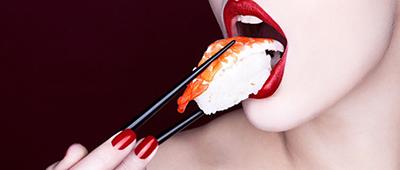
In just a few years, a delicious and original sushi dish has become an integral part of our lives. Many simply cannot imagine their life without this dish, and this is not surprising, because sushi is also surprisingly healthy. Or not?
It is generally accepted that fish and other seafood make sushi incredibly healthy, because any products of marine origin bring undeniable benefits to our body. There are even a variety of sushi diets, and they look tempting, because no one will refuse to lose weight by eating their favorite food?
The benefits and harms of such products
All the ingredients that make up these “delicacies” are natural and have a lot of beneficial properties. The products are rich in vitamins and chemical elements.
- Rice gives the body energy and maintains natural beauty.
- Fish perfectly helps maintain youth, promotes accelerated regeneration of dead cells, supports clear thinking and good memory.
- Seaweed contains iodine for the effective functioning of the thyroid gland.
- And vegetables are filled with useful vitamins and minerals to normalize metabolism and improve the immune system.
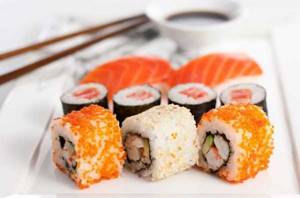
Rice vinegar
Real rice vinegar is beneficial for the body due to the content of amino acids, calcium, potassium and phosphorus. In addition, it significantly reduces the calorie content of dishes and has no contraindications for peptic ulcers and gastritis. Unfortunately, the rice vinegar that is most often found here often contains a huge amount of synthetic additives and harmful substances.
Rice is rich in minerals and complex carbohydrates, which are undoubtedly beneficial for human health. However, this applies to colored brown rice. White rice, which is used to make sushi, loses most of its beneficial qualities when processed. Rice is quite low in calories, but has a high glycemic index, which makes it an unwelcome guest in the diet of people with diabetes. In addition, rice is contraindicated if you are prone to constipation and colic.
Often, raw fish that has not undergone any heat treatment is used to prepare sushi, and given the fact that you do not know when your fish was caught and how it was stored, there is a huge risk of becoming infected with dangerous parasites from it.
Fish
Often, raw fish that has not undergone any heat treatment is used to prepare sushi, and given the fact that you do not know when your fish was caught and how it was stored, there is a huge risk of becoming infected with dangerous parasites from it.
Tuna meat is especially dangerous, as it can contain high concentrations of heavy metals and mercury.
You might be interested: 15 facts about swine flu that you didn't know
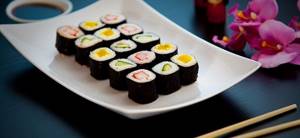
How to choose healthy sushi?
In addition, many types of sushi are also quite high-calorie dishes, which is not at all beneficial for those who do not want to gain a couple of extra pounds by eating their favorite dish. How to choose the most healthy and dietary sushi?
- Avoid eating fried or hot rolls
- Choose sushi with minimal rice content
- If you're worried about extra calories, skip the avocado and opt for cucumber and green onions.
- Avoid rolls containing cheese and mayonnaise
- Don't overuse soy sauce
- Choose sushi with cooked fish
- Don't eat sushi too often
- Order sushi only from trusted places
Choosing the right rolls and sushi
If you are familiar with the products included in the dishes, you probably know that they are mostly low in calories. But it is necessary to take into account the difference between authentic Japanese rolls/sushi and those adapted to European tastes. The latter often contain high-calorie ingredients - fatty smoked fish, soft cream cheese, mayonnaise. If you want to avoid weight gain, you should exclude such options from the menu. It is necessary to give preference to dishes where the filling is:
- Vegetables;
- Seafood:
- Lightly salted fish with low fat content (for example, tuna).
You need to be careful about frequent consumption of avocado rolls. Its pulp is also quite fatty and high in calories.
Known fact
A typical sushi roll contains between 290 and 350 calories, which is equivalent to two to three pieces of bread. And if you add mayonnaise, avocado, and fatty fish to the product, then slimming and losing weight is out of the question.
It is most beneficial to consume sachets with pieces of raw tuna or salmon, they contain more protein, Omega-3 fats and minerals.
It is best for pregnant women to refrain from this dish and eat only proven and natural products.
